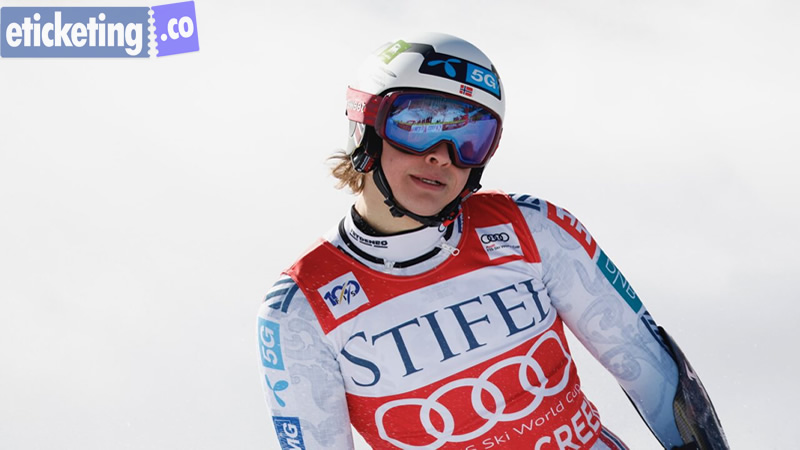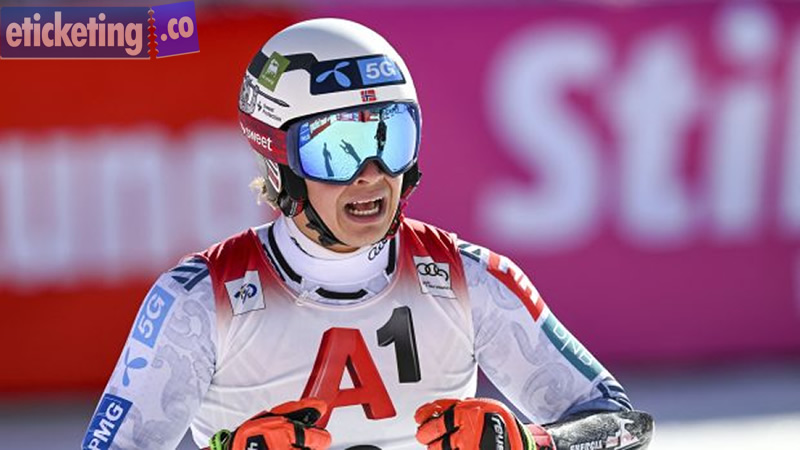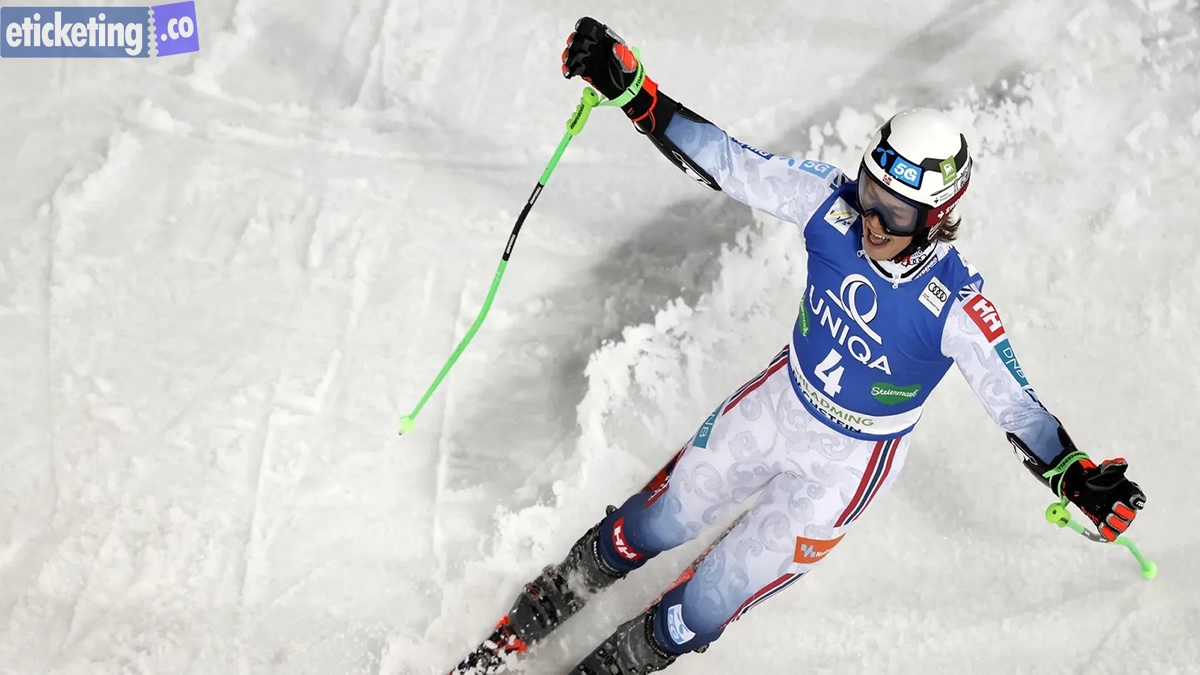In the high-speed, high-pressure world of Winter Olympic alpine skiing, athletes are constantly faced with challenges beyond their control. Weather conditions can change unexpectedly, courses can be altered, and unforeseen obstacles can arise at any moment. To succeed at the highest level, skiers must not only possess technical mastery and athleticism but also mental toughness and the ability to adapt to whatever the conditions throw their way. Steen Olsen, an emerging star in the sport, demonstrated this resilience in his recent performance at the World Cup giant slalom event in Schladming, Austria.
Olympic 2026 fans worldwide can book Winter Olympic Tickets from our online platforms eticketing.co Fans can book Olympic Tickets on our website at discounted prices. Experience the thrill of the Games in Milano Cortina and support your favorite athletes as they compete for glory.

The iconic Schladming race, held annually under the lights at Planai Mountain, is one of the most anticipated events on the World Cup calendar. Known for its challenging and steep terrain, the racecourse tests the best skiers in the world on both their speed and technical ability. This year, however, the race would throw an additional curveball at the competitors: a shortened course due to unpredictable weather conditions. The course modification, combined with snow accumulation, would put every athlete’s adaptability to the test. For Steen Olsen, this became an opportunity to showcase not only his technical prowess but also his composure under pressure.
The Schladming Challenge: Unpredictable Conditions and a Shortened Course
Schladming is a venue steeped in history and has long been associated with some of the toughest and most thrilling races in Winter Olympic alpine skiing. The giant slalom at Schladming typically features two runs, offering athletes a challenging combination of technical turns and high-speed sections. However, this year’s race was faced with unexpected weather. Snowstorms had hit the area in the days leading up to the event, causing visibility to drop and the track to become even more treacherous than usual.
To ensure the safety of the competitors, the organizers made the difficult decision to shorten the course. Instead of the usual lengthy giant slalom track, the competitors would only ski a modified version that would require even more precision in less time. The course would still have its trademark difficult turns and steep sections, but with fewer opportunities for recovery, each skier would have to rely on their sharpest skills and adaptability. You Can Read Winter Olympic 2026: Vincent Kriechmayr Shines in Saalbach Downhill with Another Stunning Victory
For athletes like Olsen, this sudden shift in course design created a unique set of challenges. In addition to the course being shortened, the snow conditions were constantly changing throughout the day. With each racer making their way down the mountain, the snow would pack down differently, affecting the grip and speed of their skis. Skiing under the lights added an extra layer of complexity, with the contrast between the illuminated snow and the surrounding dark terrain affecting depth perception. Olsen, however, was not deterred. Known for his technical skill and mental fortitude, he was ready to face the challenge head-on.
Winter Olympic 2026: Olsen’s Preparation Mental Fortitude and Strategy
One of the key aspects that set Steen Olsen apart from many of his competitors was his approach to the unpredictable nature of Winter Olympic alpine skiing. A skier with exceptional physical ability, Olsen had also honed his mental preparation to deal with the unknowns that come with every race. In the days leading up to the Schladming event, he spent considerable time studying the altered course and practicing in similar snow conditions. His focus wasn’t just on his technique but on visualizing every section of the track and imagining how he would handle each shift in terrain.

I always say that alpine skiing is as much a mental game as it is a physical one, Olsen commented in an interview before the race. When things change unexpectedly, you can’t let it throw you off. You need to focus on what you can control and trust the preparation you’ve done.
This mindset paid off in spades on race day. Olsen’s experience in navigating ever-changing conditions—he had already established himself as a versatile skier in a variety of snow conditions—enabled him to adapt quickly to the challenging weather and altered course layout. While many of the other racers struggled with the unpredictable conditions, Olsen remained calm, executing every turn with precision and staying in control despite the limited opportunities for correction on the shortened course.
Olsen’s Commanding First Run: Precision and Adaptability in Challenging Conditions
When the first run of the giant slalom began, Olsen made his presence known immediately. He was one of the early skiers to tackle the altered course, and from the outset, he demonstrated exceptional speed and precision. He had a clear strategy: maintain a steady rhythm, minimize mistakes, and capitalize on the sections where others might falter. The shortened course demanded that he execute each maneuver perfectly, as the quicker pace left no room for hesitation or error.

With conditions deteriorating as snow continued to fall, Olsen adapted by relying on his technique and instincts. He was able to gauge the track’s nuances, adjusting his turns and carving through the snow with fluidity. Despite the rapid pace of the course, Olsen’s movements were calculated. Each carve into the snow was executed with near-perfect technique, and his ability to maintain control at high speeds showcased his mastery of the sport.
Olsen’s performance in the first run set the bar for the rest of the competition. He finished in a competitive position, with a time that reflected both his technical skill and his ability to handle the course’s challenges. But with one more run left, it was clear that the race was far from over. As the second run began, the snow had continued to accumulate, making the already difficult course even more challenging. Visibility remained poor, and the track was becoming slicker, demanding even greater focus and adaptability.
Olsen’s Steady Nerves: Mastering the Second Run Under Pressure
For most skiers, the second run is often where nerves can start to take hold. The pressure to maintain a good position can lead to mistakes. For Olsen, however, this pressure only seemed to fuel his focus. He carried the same methodical approach into his second run, making subtle adjustments to his line and staying committed to his technique despite the deteriorating snow conditions.
Olympic 2026 fans worldwide can book Olympic Alpine Skiing Tickets from our online platforms eticketing.co Fans can book Olympic Tickets on our website at discounted prices. Experience the thrill of the Games in Milano Cortina and support your favorite athletes as they compete for glory.
At the finish line, Olsen had successfully navigated the shortened giant slalom course, posting a time that would secure him a podium finish. His performance had been nothing short of remarkable. He had risen to the challenge of a modified course under treacherous conditions, proving that his technical prowess and mental fortitude were enough to handle even the most unpredictable of alpine skiing environments.
Impact on Winter Olympic Alpine Skiing: A New Standard of Resilience
Steen Olsen’s performance at Schladming was not just about winning a race—it was a statement about the mental and physical demands of Winter Olympic alpine skiing. The ability to adapt to changing weather, a shortened course, and a fluctuating track requires an immense amount of skill and concentration, and Olsen had demonstrated these qualities in full force. His resilience in Schladming also set a new benchmark for future athletes, showing that success in Winter Olympic alpine skiing isn’t just about skiing fast but about mastering the ability to adapt when things go wrong.

Olsen’s victory also holds significance for the sport in a broader sense. As the World Cup circuit continues to evolve, with changing weather patterns and increased unpredictability, skiers must develop not only their technical abilities but their capacity to adjust to every new challenge. Athletes like Olsen are pushing the boundaries of what’s possible, paving the way for future generations of skiers to take risks, stay composed under pressure, and thrive in the face of adversity.
Steen Olsen’s Schladming Triumph: A Glimpse into a Promising Future in Winter Olympic Alpine Skiing
With the Schladming race behind him, Steen Olsen is already looking ahead to the rest of the World Cup season. His performance in Austria has positioned him as a skier to watch in the coming years, and his ability to handle challenging conditions has proven that he is more than capable of competing at the highest level. As Olsen continues to refine his technique and build his confidence, he will undoubtedly face even more difficult races, but one thing is certain—he is ready for whatever comes next.
For now, though, Olsen’s victory at Schladming will be remember as a defining moment in his career, one where his adaptability, speed, and precision came together to overcome the obstacles thrown his way. It was a performance that not only showcased his talents but also set a new standard for resilience and excellence in Winter Olympic alpine skiing.

Winter Olympic Alpine Skiing Steen Olsen’s Victory at Schladming: A Masterclass in Adaptability and Skill
Steen Olsen’s triumph at the Schladming World Cup event was a remarkable testament to the skier’s ability to master the unexpected. Through unpredictable weather, a shortened course, and difficult snow conditions, Olsen defied the odds and showcased what it takes to succeed at the highest level of Winter Olympic alpine skiing. As his career continues to rise, the world of Winter Olympic alpine skiing will undoubtedly see more of this talented and resilient athlete. And as athletes and fans alike reflect on his performance, they will remember one key lesson: in the world of Winter Olympic alpine skiing, the ability to adapt is just as important as the ability to ski fast.

The magic and excitement as fans from around the world gather to celebrate the spirit of the Games. Secure your Olympic Opening Ceremony Tickets now and create memories that will last a lifetime at the unforgettable Winter Olympic 2026.
